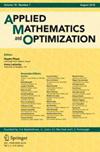马尔可夫过程经验测度的Wasserstein收敛率
IF 1.7
2区 数学
Q2 MATHEMATICS, APPLIED
引用次数: 0
摘要
对于遍历马尔可夫过程的经验测度,估计了Wasserstein距离的收敛速度,并且在某些特定情况下估计可能是尖锐的。主要结果应用于被现有结果排除的典型模型的从属关系,包括:\({\mathbb{R}}^{n}\times {\mathbb{R}}^{m}\)上的随机哈密顿系统,\({\mathbb{R}}^n\times \mathbb S^{n-1},\)上的球面速度朗格万过程,多维Wright-Fisher型扩散过程和稳定型跳跃过程。本文章由计算机程序翻译,如有差异,请以英文原文为准。
Wasserstein Convergence Rate for Empirical Measures of Markov Processes
The convergence rate in Wasserstein distance is estimated for empirical measures of ergodic Markov processes, and the estimate can be sharp in some specific situations. The main result is applied to subordinations of typical models excluded by existing results, which include: stochastic Hamiltonian systems on \({\mathbb{R}}^{n}\times {\mathbb{R}}^{m}\), spherical velocity Langevin processes on \({\mathbb{R}}^n\times \mathbb S^{n-1},\) multi-dimensional Wright–Fisher type diffusion processes, and stable type jump processes.
求助全文
通过发布文献求助,成功后即可免费获取论文全文。
去求助
来源期刊
CiteScore
3.30
自引率
5.60%
发文量
103
审稿时长
>12 weeks
期刊介绍:
The Applied Mathematics and Optimization Journal covers a broad range of mathematical methods in particular those that bridge with optimization and have some connection with applications. Core topics include calculus of variations, partial differential equations, stochastic control, optimization of deterministic or stochastic systems in discrete or continuous time, homogenization, control theory, mean field games, dynamic games and optimal transport. Algorithmic, data analytic, machine learning and numerical methods which support the modeling and analysis of optimization problems are encouraged. Of great interest are papers which show some novel idea in either the theory or model which include some connection with potential applications in science and engineering.

 求助内容:
求助内容: 应助结果提醒方式:
应助结果提醒方式:


